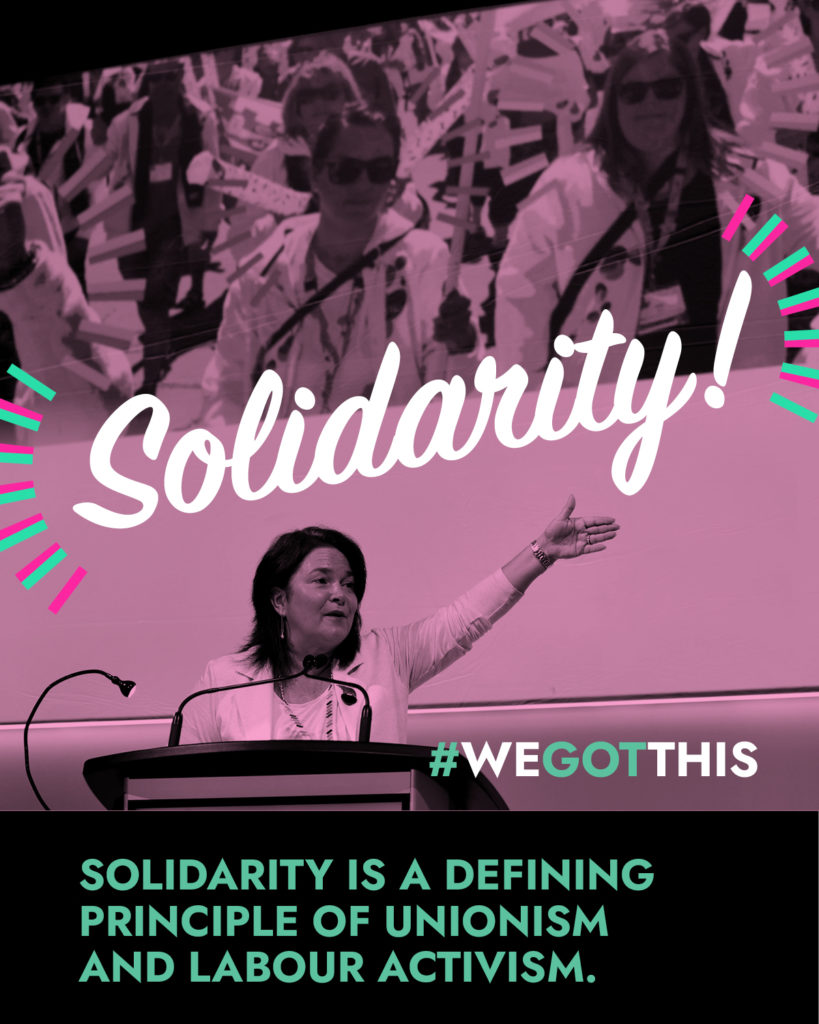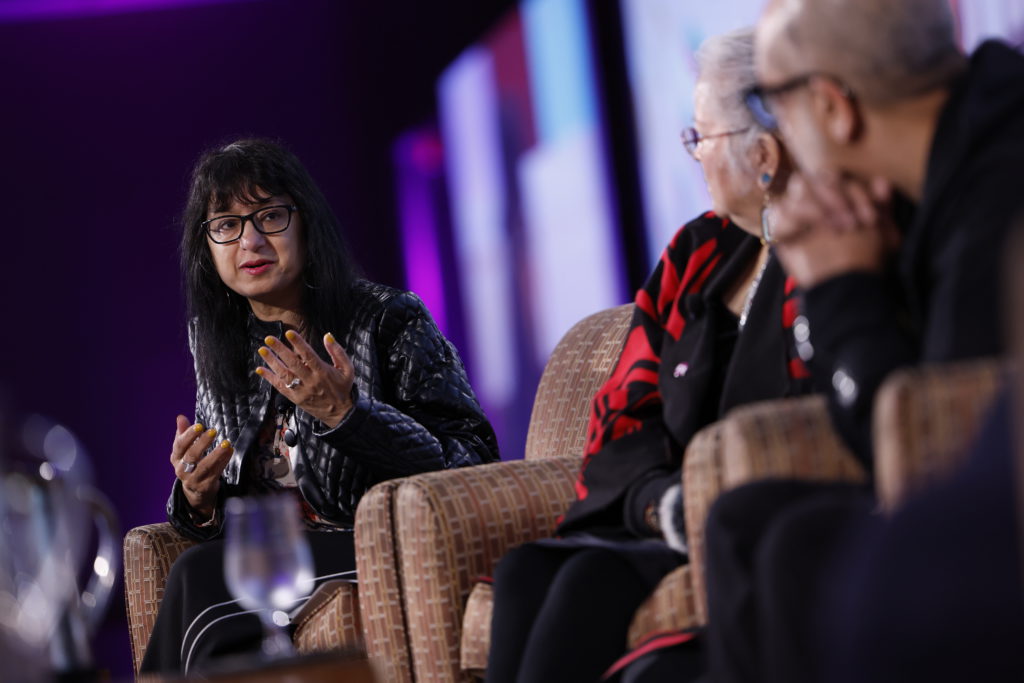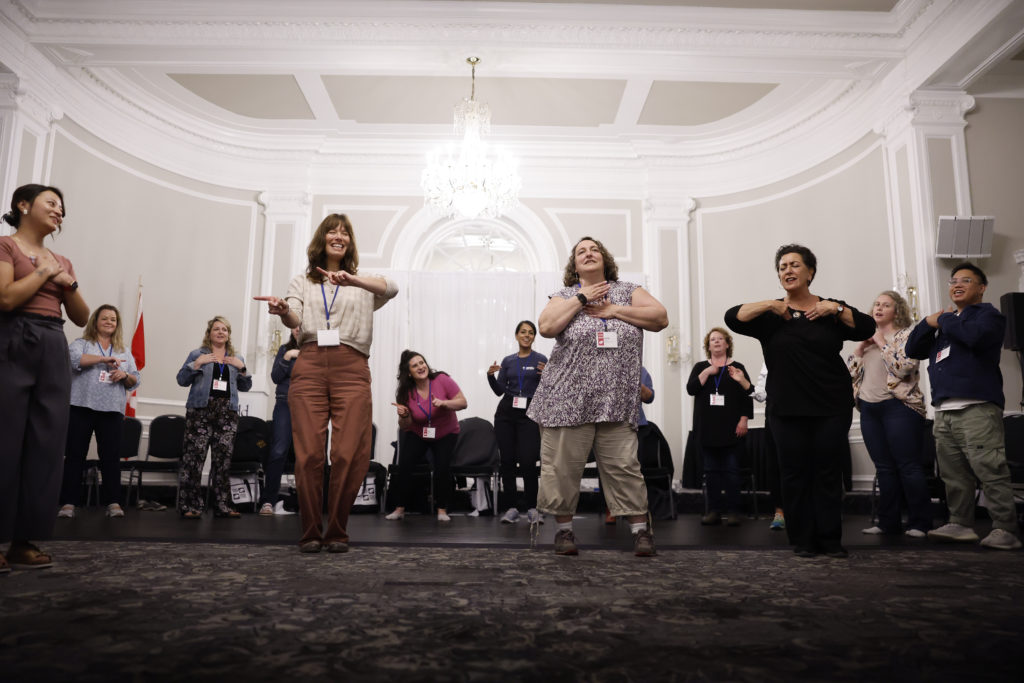

The struggle to create a new definition of solidarity for a 21st century union movement in a diverse Canada was the focus of panelists and delegates at Tuesday morning’s plenary session of the CFNU Biennium.
The goal of the session, explained moderator Hanif Karim, a human rights and equity officer with the British Columbia Nurses’ Union, was “to offer a set of reflections on the meaning of solidarity … so we can create a kind of working definition for ourselves of solidarity.”
The working definition that emerged from those reflections emphasized many traditional trade union principles – for example, the need for union leaders to be driven by the priorities of grassroots members.
“We need to put out grassroots members at the top,” observed panel member Dawn Armstrong, RN, chair of the Ontario Nurses Association’s Anti-Racism Advisory Team.
But some new ideas and approaches emerged as well: a growing emphasis on community and finding practical ways to reflect the diversity of membership.
“Unions have become transactional,” said Armstrong. “People look at unions for ‘what can you do for me?’. We need to bring it back and make it a community, rather than a transaction.”
Panel member Connie Paul, a 34-year-old nurse working with the Snuneymuxw First Nations on Vancouver Island, pointed to a community health care metaphor of a coastal canoe that could be applied to how we view union solidarity.
“No one person in that canoe is more important than the person in front of you,” said Paul. “Solidarity for me was about paddling home.”
Manju Varma counseled union leaders to use the privilege they enjoy to benefit union members and others in society who do not have that privilege. It’s not a bad thing to have privilege, she explained, but it is a bad thing not to use it to serve those in your community who do not have it.
Panelist Jan Simpson, national president of the Canadian Union of Postal Workers, agreed: “For those of us who do have privilege, it’s important to use the privilege to help people move forward, not to put up barriers.”
“You can’t just hold your employer responsible,” she reminded delegates earlier in her remarks.
Union leaders themselves must be truly committed to the goals of equity and diversity.
The atmosphere in the room was charged with anticipation as nurses convened for the first day of workshops at the biennial convention. This time, their focus shifted to planning for the life after their tireless dedication and service to individuals across the country.
As the room hushed, financial expert and presenter Jim Yih took the stage, reminding nurses that retirement planning goes far beyond numbers, calculations and money.
Undoubtedly, financial security remains a cornerstone of a successful retirement, but Yih swiftly reminded the nurses that true fulfillment lies in crafting a retirement that reflects your personal passions and aspirations.
He encouraged the nurses to take a moment to envision what they want their retirement to be and allow that vision to guide them in developing a plan that is unique to them; one that includes cherished hobbies, meaningful causes and experiences that bring them joy.
Starting early is key, and then align the blueprint with existing interests and passions. This will make the transition to retirement a more organic and satisfying experience.
As the nurses absorbed the information shared and contemplated their future, one realization became abundantly clear: the beauty of a successful and fulfilling retirement lies in the intersection of financial security and a vibrant meaningful lifestyle.
And that perfect moment to retire? You will know when you are prepared to embark on this new chapter. Ultimately, the best time to retire is when you feel ready.

Outside it was cloudy and raining but beneath the glimmering chandeliers of the grand Georgian Ballroom of the Rodd Charlottetown Hotel nurses danced the afternoon away in one of the most energetic workshops of the CFNU biennial convention.
Anyone who might have entered the “Our resilient selves: rediscovering vitality, strength, and joy through movement and dance” workshop with a hint of skepticism showed little sign of hesitancy by the end of the afternoon as the sound of laughter and shuffling feet filled the room.
Facilitated by dance and movement therapist Patricia Capello, the experimental workshop guided more than 60 nurses to recognize and appreciate themselves as they explored simple individual and communal creative dance and movement exercises.
“My goal is to spread the word about how much the body has to say,” Capello told workshop participants. “You can learn a lot about what you can do as you move your body.”
Capello was a senior dance/movement therapist and Acting Team Leader for the therapeutic activities service at Maimonides Medical Center in Brooklyn, New York, and has served for more than 16 years on the Board of Directors of the American Dance Therapy Association.
Recognizing that nurses feel a constant pressure to put the needs of their patients and co-workers ahead of themselves, Capello encouraged nurses to make a conscious effort to focus on their own bodies.
When nurses weren’t on their feet during the workshop, they were being led through breathing, stretching and relaxation exercises.
“You all work with people’s bodies all day long, and sometimes we neglect our own bodies because we say we’re going to power through it,” she said as she challenged the nurses to think about where in their body they feel stressed and where they draw strength from.
“We just met each other, we got up and danced together,” Capello said after the nurses finished a room-wide dance-off to the sound of Bruno Mars.
“What did people notice when they looked around? Oneness. Smiling. Being together. Trust. We could talk about this for an hour and do a PowerPoint, but it doesn’t really resonate until you do it,” she said. “You were recognizing how people were moving. We had similarities and differences. But it made us a beautiful oneness.”
It’s not all doom and gloom, but faith in Canada’s public health care system is slipping after years of hospitals being hit hard by COVID-19 and chronic staffing shortages, Stephen Staples of the Canadian Health Coalition told a group of CFNU Biennium delegates yesterday.
“The numbers are starting to shift and confidence is down,” said the Canadian Health Coalition’s Director of Policy and Advocacy. But there are things that can be done by nurses and other supporters of public health care to help reverse that trend.
With CHC Media Director Anne Lagacé Dowson and National Operations Director Tracy Glynn, Staples offered tips on how to identify specific problems confronting health care, set them out for politicians, journalists and the public, and proposed solutions.
“By the end, everyone’s going to have a personal political action plan,” he promised. That’s a necessity, he added, because “we are the front lines of the protection of our health care system.”
The workshop covered such topics as identifying the spectrum of allies and opponents, picking targets, mapping out who is most likely to be able to help and who can be moved to a more favourable position, and defining goals, strategies and tactics for a lobbying effort.
Lagacé Dowson described how nurses’ knowledge and experience can be used to create compelling stories that will engage the interest of media – after all, she told the delegates, “media is showbiz.”
As the workshop drew to a close, Staples told participants: “you now have before you a pretty good idea of your personal political action plan.”
“Hopefully you feel like you’re in a position to try it out in real life.”